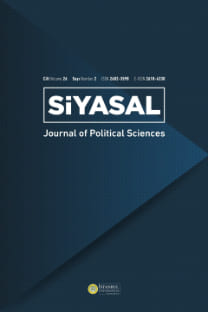Enemy Images and Conflict
Bu çalışma sosyal ve uluslararası uyuşmazlıklarda çok sık gözlenen hasmane önyargılara ilişkin analitik bir tartışma sunmaktadır. Çalışmada vurgulanan ana tema hasmane önyargıların uyuşmazlığa taraf partiler arasında psikolojik bariyerler yaratarak çözümü zora soktuğu, bu sebeple ortadan kaldırılmalarının öncelikli bir zorunluluk olduğudur. Sırasıyla hasmane önyargıların nedenleri, uyuşmazlığa taraf partiler üzerindeki olumsuz etkileri ve bunlarla mücadele yollan ele alınmaktadır. Ayrıca negatif önyargıların çok boyutlu bir sorun olduğu, bu yüzden de çok yönlü bir mücadele ortaya konması gereğinin altı çizilmektedir.
Hasmane Önyargılar ve Uyuşmazlık
This work provides an analytical discussion for commonly-held negative stereotypes in conflict situations, known as enemy images. It emphasizes that enemy images cerate serious obstacles to conflict resolution by creating psychological barriers between the parties and making them cognitively antagonistic to each other. Therefore, removing hostile images must be a first priority on the way to resolving a conflict. The underlying causes of enemy images, their impact on the behaviors of conflicting parties and strategies utilized to remove such images are discussed, in that order. Special attention is given to the need for a comprehensive effort to cope with enemy images.
___
- Aho, James A., This Thing of Darkness: A Sociology of the Enemy, (Seattle: University of Washington Press, 1994).
- Allport, Gordon W., The Nature of Prejudice, (New York: Beacon Press, 1954).
- Azar, Edward E., The Management of Protracted Social Conflict, (Dartmouth: Aldershot, 1990).
- Breslin, William J., "Breaking Away From Subtle Biases", in Negotiation Theory and Practice, (Cambridge, Mass: Harvard Law School Press, 1995).
- Brockman, John. The Third Culture: Beyond the Scientific Revolution, (New York: Simon & Schuster, 1996).
- Bronfenbrenner, Urie. "The Mirror-Image in Soviet-American Relations", Journal of Social Issues, Vol. 17, No. 3, 1961.
- Coser, Lewis. The Functions of Social Conflict, (New York: Free Press, 1956).
- Daugherty, James A and Pfaltzgraff, Robert L., Contending Theories of International Relations, (New York: Harper Collins, 2001).
- Eckhard, W., "Making and Breaking Enemy Images", in Bulletin of Peace Proposals, Vol. 22, No. 1, 1991.
- Erikson, Erik H., "Ontogeny of Ritualization", in Psychoanalysis: A General Psychology, (New York: International University Press, 1995).
- Finlay, David et al., Enemies in Politics, (Chicago: Rand-McNally, 1967).
- Freud, Sigmund. "Civilization and Its Discontents", in The Standard Edition of the Complete Psychological Works of Sigmund Freud, (London: Hogarth Press, 1961).
- Fromm, Erich. The Sane Society, (New York: Rinehart & Company, Inc, 1955).
- Keen, Sam. Faces of the Enemy, (San Francisco: Harper Collins, 1986).
- Kelman, Herbert. "The Interactive Problem Solving Approach", in Managing Global Chaos, (Washington D.C.: United States Institute of Peace, 1996).
- Lorenz, Konrad Z., On Aggression, (New York: Harcourt Brace and World, 1966).
- Luostrainen, H., "Finnish Russophobia: The Story of an Enemy Image", in Journal of Peace Research, Vol. 26, No. 2, 1989.
- Montville, Joseph V., "The Arrow and the Olive Branch: A Case for Track Two Diplomacy", in The Psychodynamics of International Relationship, (Lexington, Mass: Lexington Books, 1990).
- Osgood, C. E., "The GRIT Strategy", in Thinking About Nuclear Weapons, (London: Croom Helm, 1985).
- Pruitt, Dean G, and Rubin J. Z., Social Conflict, (New York: McGraw-Hill, 1994). Pruitt, Dean G., "The Psychology of Social Conflict and Its Relevance to International Conflict", in Beyond Confrontation: Learning Conflict Resolution in the Post Cold War Era, (Ann Arbor: The University of Michigan Press, 1995).
- Rafael, M., "On Dehumanizing the Enemy", in The Psychodynamics of International Relationships.
- Ryan, Stephen. Ethnic Conflict and International Relations, (Brookfield, Vermont: Dartmouth Publishing Com, 1995).
- Sherif, Muzaffer. Group Conflict and Cooperation, (Routledge: London, 1967).
- . "Experiments in Group Conflict", in Science, Conflict, and Society, A Collection of Readings from the Scientific American, (W. H. Freeman: San Francisco, 1969).
- Stagner, Ross. Psychological Aspects of International Conflict, (Belmont, CA: Brook and Cole, 1967).
- Stein, Janice G., "Image, Identity, and Conflict Resolution", in Managing Global Chaos.
- Volkan, V. D., The Need to Have Enemies and Allies, (New Jersey: Jason Aronson Inc., 1988).
- . "An Overview of Psychological Concepts Pertinent to Interethnic and/or International Relationships", in The Psychodynamics of International Relationships.
- Volkan, Vamik D. and Itzkowitz, Norman. Turks and Greeks: Neighbors in Conflict, (Cambridgeshire, England: The Eothen Press, 1994).
- Wahlstrom, Riitta. "The Challenge of Peace Education: Replacing Cultures of Militarism", in New Agendas for Peace Research: Conflict and Security Re-examined, (Boulder, CO.: L. Rienner Publishers, 1992).
- ISSN: 1303-1260
- Yayın Aralığı: Yılda 2 Sayı
- Yayıncı: İstanbul Üniversitesi
Sayıdaki Diğer Makaleler
Çalışan Kadının Sorunu: Çatışan Roller, Sorumluluklar ve Beklentiler Gıda Sektörü Örneği
Avrupa Birliği Anayasal Düzeninde Temel Hakların Serüveni
Kamu Hizmetlerinin Daha İyi Görülebilmesi İçin Alternatif Bir Yönetim Yaklaşımı: Elektronik Devlet
Yolsuzluk ve Yolsuzluğun Vergi Yapısı Üzerine Etkileri
Çok Uluslu İşletmelerin Faaliyet Gösterdikleri Ülkelerde Karşılaştıkları Muhasebe Sorunları
